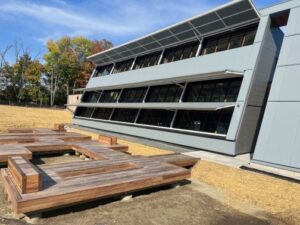Camp TEKO sits on the same 19 acres of land on Lake Minnetonka as it did when the Temple Israel Men’s Club bought the property in 1965, when it was a Boy Scout Camp. The buildings on the site are also largely from that time. Until now, that is.

Maya, Eliana and Ava Goldstein enjoy treats during the Camp TEKO community open house on Oct. 1 (Photo by Lonny Goldsmith/TC Jewfolk).
Four years after starting a fundraising campaign to renovate Camp TEKO, Temple Israel welcomed hundreds of people to the camp on Oct. 1 for a community grand opening and ribbon cutting. Initially a $12.8 million campaign, $13.25 million has been raised with another $500,000 to go, which will enable the construction of new cabins near the state-of-the-art Discovery Center.
One of the significant parts of the construction of the Discovery Center is that it’s enabling TEKO to add more campers going forward.
“The Discovery Center has multiple uses, but it has a place where the entire camp can come together and have a song session, have a ruach session, and a safe room for inclement weather,” Rabbi Marcia Zimmerman said. “That’s part of why we’ve had waiting lists, because we haven’t had a safe room that could hold the entire camp.”
The camp had topped out at 135 campers, and can now add another 30.
“It’s major because we’ve had to have these waitlists because of safety, not because we don’t want to have more campers,” she said.
The camp has also been renamed to Camp TEKO: the Rabbi Max A. and Bernice Shapiro Campus, thanks to an anonymous gift. Rabbi Shapiro was leading the synagogue when it bought and developed the site nearly 60 years ago.
“Rabbi Shapiro saw this as the jewel in the crown of his rabbinate,” Zimmerman told the assembled crowd.
The renovated camp will also have significant ecological improvements, including solar panels, 10 miles of underground piping for geothermal heating and cooling, and special gardens that collect runoff and clean the water before it flows back into Lake Minnetonka.
“It’s cutting edge for anywhere, not just a camp,” said Melissa Rappaport Schifman, whose family has been very involved in the campaign. “Sustainability is a Jewish value.”
The solar panels are on louvers, which means they are adjustable. In the summer, they can be angled upwards to take advantage of the higher sun angle while also letting light into the Discovery Center. In the winter, they can be closed to capture sun that is at a lower angle while also helping to insulate the building.
The sustainability changes at camp are part of the larger changes that Temple Israel is making. A 2018 strategic plan directs that the synagogue addresses sustainability in everything they do. A small solar panel array was added to the roof of the building which powers the Ner Tamid at the synagogue, and their plan is to reach net zero for energy and waste by 2030.
“Every aspect of this project has been sustainability,” Zimmerman said.
Programmatically, the new spaces will also have a teaching kitchen for campers to learn how to cook and dive into Jewish culture that way.
“Culture is taught through food and taking herbs off the land and making things that are beautiful and amazing,” Zimmerman said.
The kitchen has a dual purpose: It will double as a catering kitchen for events held at camp. Through strategic plans in 2010 and 2014, Zimmerman said that the conclusion was to use Camp TEKO more.
“We can actually have events at TEKO now so much more so than we ever have been able to do before,” Zimmerman said. “We have a new renovated indoor space and new renovated chapel, and a lakefront that is now open between swimming and boating, which hasn’t been the case for at least 20 years because of erosion.”
For the renovated chapel, ash trees from the site were used for bleacher seating.
One upcoming feature of the renovation will be art by Native American artist Angela Two Stars, who had come to talk with the TEKO staff about the Lakota tribes’ connection to the land where camp is.
“She said ‘We don’t see ourselves as owning the land; we see ourselves as being stewards of the land. And so do you,’” Zimmerman recalled, adding that Two Stars talked about bringing culture and ethnicity from generation to generation, which is also important to the Jewish community.





Umm we need more pictures!